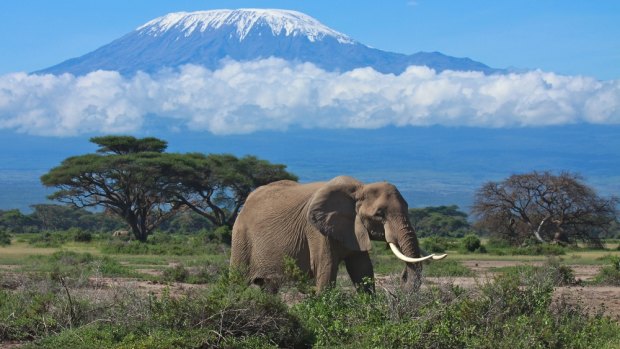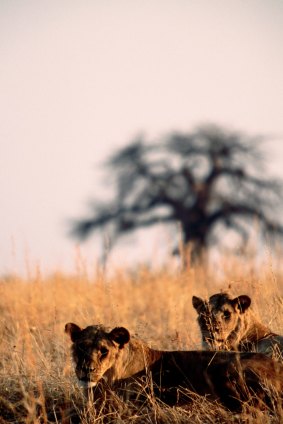This was published 8 years ago
Tanzania safari, Selous Game Reserve: On Safari in Africa's largest game park
Few visitors make it to Tanzania's southern game parks. Therein lies the attraction.
By Mark Daffey

A mighty elephant.
There's a noise in the bushes. I can't see much, just a flash of colour. Is it an impala? It's possible. We've seen several already this morning.
I step forward.
"Stop!" warns our guide, David. "Come close." He waves my wife and me over. There's a sense of urgency in his voice that's unnerving.

Close for comfort: Lions watch in the long grass at Siringa. Ruaha National Park, Iringa, Tanzania.Credit: Mark Daffey
About 50 metres ahead of us, a bull elephant appears, fanning its ears as it steps out from behind the scrub. In my experience, when an elephant fans its ears it's meant to be a threat; it's telling us to back off. And if we don't, it's likely to charge. But it doesn't; it trots away in the opposite direction.
"Come!" David barks, leading us away from the elephant, and away from the Rufiji River, where others just like it bathe and drink and socialise. But then, just as suddenly as it materialised from the bushes, the elephant stops and turns to face us.
"Jesus, it's going to charge," I whisper. I glance across at David, waiting for our cue. He appears calm, but is also on full alert, his eyes darting about constantly. "There may be others," he says.
David breaks into a jog, darting from one tree to another in a zigzagging pattern, like he'd advised us to do earlier. Michelle and I follow, hot on his heels. Every few steps I peek over my shoulder.
He leads us away, until we can no longer see or hear the elephant. But oddly, that makes me want to go back. I've come here to see wild animals, not run away from them.
It's the first morning of a week-long safari through three of Tanzania's southern game parks, and our close encounter with Africa's largest wild animal has given us a flying start. During previous visits to east Africa I joined game drives through some of the better-known parks further north, such as Serengeti and Ngorongoro, or Maasai Mara in Kenya, each a fantastic experience. We managed to tick off the "Big Five", and more. But we also came to doubt the authenticity of wildlife safaris here, after countless safari vehicles jostled for position each time a call went out over the radio about a leopard or lion or cheetah being spotted. East Africa's game reserves are meant to be one of the world's last great wilderness regions, yet at times they felt like theme parks.
So we've ventured further south, to parks where visitor numbers are a fraction of the hundreds of thousands found in the parks up north. We're hoping to share in some genuine wildlife experiences, far from the tourist hordes, and already we've got more than we bargained for. Running from elephants is as real as it gets.
Our first safari in Selous Game Reserve – Africa's largest game park – is the last time we'll search for animals on foot. For the rest of the week our safari time will be more conventional, encased inside an open-top Land Rover Defender. It sounds far safer than our walking safari out and around Selous' Ndovu Camp area, until our guide in Mikumi National Park relates a story about an experience he once shared with an Italian client.
"We found a pride of lions and parked close so we could watch them," he says. "But we were too close. Two of the lions jumped up on our vehicle: one on the bonnet and the other on top, where the roof was open. Nothing was between us, so I started the engine, put it into gear and took off. The lion on the bonnet jumped off but the one on top stumbled and got a leg caught inside the car. It eventually got out, but only after what felt like a very long time. After that, the Italian didn't want to go on safari any more."
A road connecting the Tanzanian capital of Dar Es Salaam with the south-western border town of Mbeya cuts right through the middle of Mikumi, slicing it in half. Before we reach camp we've spotted impalas, giraffes, zebras, warthogs and bushbucks. There are also plenty of elephants. And when vehicles and elephants meet on this road, a Mexican standoff often ensues.
"The elephants of Mikumi are known for chasing cars," our park ranger Meelo says. "A bull elephant once ran after us for 400 metres. I was on a winding dirt track at the time and had to follow it to try and get away. The elephant could run in a straight line though, so it almost caught us. We were lucky. When it tried to follow us, I turned sharply. It overbalanced, toppling onto its back with its legs in the air."
After a morning safari through Mikumi's flat northern section we move on to Ruaha National Park, our last safari destination, near the centre of Tanzania. It's the prettiest of the three parks we visit: hillier and higher, with baobabs aplenty and the languid Grand Ruaha River marking its eastern boundary. But this time, it's not just recalcitrant pachyderms we're told to fear.
Elephants, hippos, lions and hyenas all have a habit of wandering through our camp ground at night, making sleeping in tents virtually suicidal. Fires glow outside each of the sturdy metal accommodation bandas to deter animals from entering the camp; another flickers beside the community toilet block.
On our second night, when Michelle opens our banda door for the short walk to the dining room, it's pitch black outside. The moon hasn't yet risen and myriad stars sparkle. When I close the door behind us, I mockingly shine the torch about, scanning our campground for rogue animals. All's clear – as I expect at this early hour – and we walk towards our dinner appointment. Then something catches Michelle's attention.
On the grass to our right, in our torch beam, is the biggest hippo I've ever seen, standing no more than 10 metres away.
"What do we do?" asks Michelle.
"Run!" I say, before the two of us hightail it to the the nearest banda. We peer round the corner.
Fortunately the hippo retreats into the bushes, out of sight, presenting an opening that's too tempting to ignore. "Come on," I say to Michelle. "Let's go for it."
We inch forward carefully, always watching the bushes that the hippo somehow melted into. At the car park, we find our driver wiping dust from the dashboard of our Land Rover, and I immediately warn him about the hippo hiding behind the bushes.
"A hippo? I thought I heard something over there," he says, nonchalantly. "Don't worry, the hippos won't hurt you. It's the elephants and lions you have to be careful of around here."
South African Airways offers the cheapest flights to the Tanzanian capital of Dar Es Salaam. Return flights from Sydney or Melbourne from $1800.
GETTING AROUND
Book a tour that can pick you up at the airport and drive you straight to Selous Game Reserve. We travelled with local safari group Hit Holidays (hitholidays.com). Safaris typically cost about $100 per person per day in Tanzania, with a vehicle and driver, food, accommodation and park fees included. Our accommodation was on stretcher beds in simple canvas safari tents or metal bandas.There are more upmarket options in each of the three parks.
The writer travelled at his own expense.
Sign up for the Traveller Deals newsletter
Get exclusive travel deals delivered straight to your inbox. Sign up now.